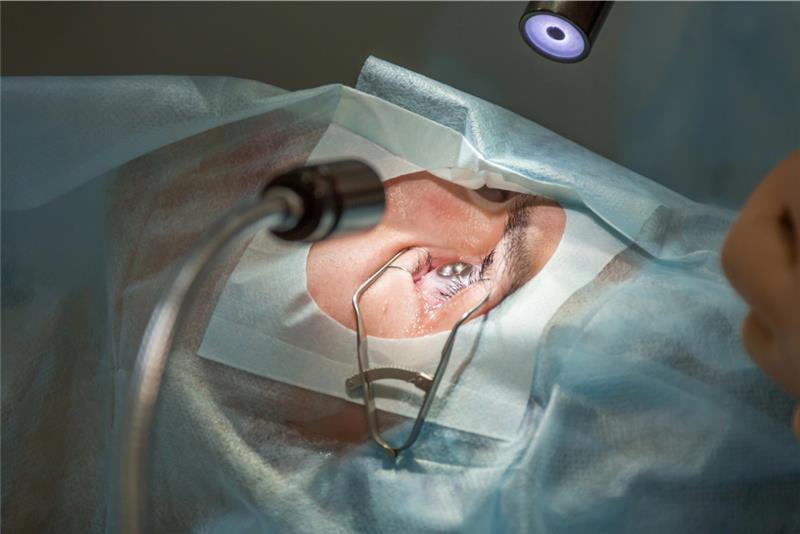Imagine waking up every morning with crystal-clear vision, no fumbling for glasses on the nightstand or the hassle of inserting contact lenses.
The allure of this freedom is powerful, and it’s no wonder that over 700,000 LASIK procedures are performed in the U.S. each year.
We’ll guide you through what LASIK surgery entails, help you assess your LASIK candidacy requirements, and explore the potential LASIK eye surgery benefits, ultimately helping you determine if it’s the right choice for your unique vision needs.
What Is LASIK? A Quick Overview
LASIK is a sophisticated laser surgery designed to correct common refractive errors. Think of your cornea, the clear front surface of your eye, as the initial lens that helps focus light.
In people with nearsightedness (myopia), farsightedness (hyperopia), or astigmatism, the cornea isn’t perfectly shaped, causing light to focus incorrectly on the retina at the back of the eye, resulting in blurry vision.
During LASIK surgery for vision correction, a highly precise excimer laser is used to gently reshape the cornea. For nearsightedness, the cornea is flattened; for farsightedness, it’s made steeper; and for astigmatism, the irregular shape is smoothed out. This reshaping allows light to focus directly onto the retina, resulting in sharper, clearer vision.
Benefits of LASIK
The appeal of LASIK lies in its numerous potential benefits:
-
- Freedom from glasses and contacts: This is the most significant advantage for many, offering greater convenience and a more natural appearance. Imagine the ease of swimming, playing sports, or simply waking up with clear sight.
-
- Quick procedure and fast recovery: The LASIK procedure itself typically takes only 15–20 minutes for both eyes. While individual experiences vary, many patients notice significant vision improvement within 24–48 hours.
-
- Long-lasting results: For most individuals, the vision correction achieved through LASIK is long-lasting, often providing years of improved vision without the need for glasses or contacts.
-
- Minimal discomfort: Numbing eye drops are used before and during the procedure, ensuring little to no pain. Post-operative discomfort is usually mild and temporary.
-
- Enhanced convenience for active lifestyles: Whether you’re an avid athlete or simply enjoy an active life, LASIK eliminates the frustrations of dealing with glasses or contacts during physical activities. Travel also becomes more convenient without the need to pack and care for lens solutions.
Who Is a Good Candidate for LASIK?
Generally, good LASIK candidate requirements include:
-
- Age consideration: Most surgeons prefer patients to be 18 years or older, as vision tends to stabilize in adulthood.
-
- Eye health: You should have generally healthy eyes free from significant eye diseases such as glaucoma, cataracts, or severe dry eye. Active eye infections also disqualify you temporarily.
-
- General health: Certain autoimmune diseases like lupus or rheumatoid arthritis can affect healing after LASIK. Uncontrolled diabetes can also be a contraindication. Your overall health will be reviewed during your consultation.
-
- Vision stability: Your prescription for glasses or contact lenses should have been stable for at least 1–2 years prior to considering LASIK. Significant fluctuations in vision may indicate an underlying issue.
-
- Corneal thickness: Adequate corneal thickness is essential for a safe and effective LASIK procedure. The laser removes a small amount of corneal tissue, so sufficient thickness is needed to maintain the structural integrity of the eye.
The only way to definitively answer the question, “Am I a good candidate for LASIK?” is through a comprehensive eye exam and consultation with a qualified eye surgeon. This evaluation will assess all the necessary factors to determine your suitability for the procedure.
Who Should Consider Alternatives to LASIK?
While LASIK is a popular and effective procedure, it’s not the best option for everyone. Certain individuals may be better suited for alternative vision correction methods:
-
- Individuals with very high prescriptions or thin corneas: In these cases, LASIK might not be the safest or most effective approach.
-
- People with certain health conditions: Uncontrolled diabetes or autoimmune disorders can impair healing and increase the risk of complications.
-
- Those with severe dry eyes: LASIK can sometimes temporarily worsen dry eye symptoms. Individuals with pre-existing severe dry eye may need to explore other options.
-
- Pregnancy: Hormonal changes during pregnancy can affect vision stability, making it advisable to postpone elective procedures like LASIK.
If LASIK isn’t the right fit, several alternatives exist, including:
-
- PRK (Photorefractive Keratectomy): Similar to LASIK but without creating a corneal flap. It’s often considered for patients with thinner corneas.
-
- Implantable contact lenses (ICLs): These are surgically implanted lenses that work like permanent contact lenses to correct vision.
-
- SMILE (Small Incision Lenticule Extraction) procedure: A newer laser vision correction procedure that involves creating a small lenticule within the cornea and removing it through a small incision.
What to Expect During the LASIK Process
Pre-operative Consultation
This is an important appointment where a top LASIK surgeon will conduct a thorough eye exam. This includes precise eye measurements, corneal mapping to assess its shape and thickness, and a detailed review of your medical history. This consultation is your opportunity to ask questions and discuss your expectations and the cost of LASIK in Los Angeles.
The Day of Surgery
On the day of your LASIK surgery, you’ll be given numbing eye drops to ensure comfort. The procedure itself is relatively quick. The surgeon will create a thin flap on the cornea, then use the excimer laser to reshape the underlying corneal tissue according to your personalized treatment plan. The flap is then gently repositioned and naturally adheres without the need for stitches. No general anesthesia is required.
Recovery Timeline
Immediately after the procedure, you may experience some mild discomfort, a gritty sensation, or light sensitivity. Vision improvement is often noticeable within 1–2 days. Following the surgeon’s instructions regarding the LASIK recovery time and expectations is important. This typically involves avoiding rubbing your eyes, using prescribed eye drops, and refraining from strenuous activity for a few weeks. Regular follow-up appointments will monitor your healing progress.
Risks and Considerations
While LASIK is generally safe and effective, it’s important to be aware of potential risks and considerations.
Temporary Side Effects
These can include dry eyes, glare, halos, or starbursts around lights, particularly at night. These symptoms usually subside within a few weeks or months.
Rare Complications
Although uncommon, potential complications include undercorrection or overcorrection of vision, flap-related issues, and regression (where vision changes over time).
Importance of Choosing an Experienced Surgeon
Selecting one of the top LASIK surgeons in Los Angeles significantly minimizes the risk of complications and maximizes the chances of a successful outcome. Look for board-certified ophthalmologists with extensive experience in refractive surgery.
FAQs: Lasik Surgery
Is LASIK permanent?
While the structural changes to your cornea are permanent, your vision can still change naturally over time due to aging or other factors.
Will I still need reading glasses after LASIK?
LASIK primarily corrects distance vision. As you age, you will likely still develop presbyopia, the natural age-related loss of near focusing ability, typically requiring reading glasses in your 40s or 50s.
How soon can I return to work or drive after LASIK?
Most people can return to light activities within a day or two and can often drive within 24-48 hours, after a follow-up appointment confirms adequate vision.
Does LASIK hurt?
No, numbing drops are used to ensure you feel little to no pain during the procedure. Post-operative discomfort is usually mild and temporary.
Can LASIK correct astigmatism?
Yes, LASIK can effectively correct nearsightedness, farsightedness, and astigmatism.
What happens if my vision changes years later?
If your vision changes significantly after LASIK, you may consider wearing glasses or contact lenses for specific tasks. In some cases, a LASIK enhancement procedure may be an option.
Conclusion
The potential LASIK eye surgery benefits are significant, but determining if you meet the LASIK candidacy requirements is key. A thorough evaluation by one of the best ophthalmologists in Los Angeles is the necessary first step.
Remember, the decision to undergo LASIK should be informed and guided by a trusted eye care professional. If you’re in Los Angeles, Newport Beach, Beverly Hills, or Glendale, and dreaming of a life free of visual aids, get in touch with us today.
For comprehensive eye care beyond refractive surgery, remember to also consider visiting us for a general eye doctor for routine eye health checks.
Schedule a consultation with Soroudi Advanced Lasik & Eye Centers, the best ophthalmologists in Los Angeles to discuss options and take the first step towards a clearer, glasses-free future.



